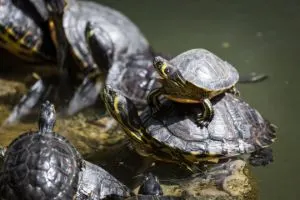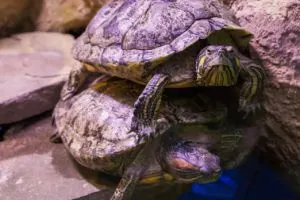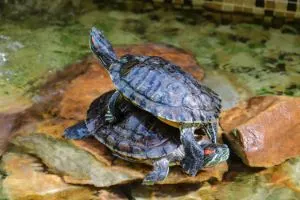Turtle stacking usually occurs when turtles are basking. Turtles bask to receive warmth and UV rays from a light/heat source. In nature, the source is the sun and in captivity it should be from your heat lamp and UVB setup.
If you have ever seen a relatively large group of turtles basking, then you know they like to climb up on one another. This is particularly popular among turtles kept in captivity.
Turtles usually climb onto one another when there isn’t enough room on the basking platform of their choice.
You may have asked yourself, ‘Why do turtles stack?’ There has to be a logical explanation for this innate behavior, right? Well, you aren’t wrong.
Also, a turtle will try to climb as high as possible if a shadow is cast over its body. As high as possible usually ends up being on another turtle’s back.
Table of Contents
Why Do Turtles Stack?
Turtles Stack To Bask In A Limited Space

As explained, turtles stack in order to receive sunlight and warmth. If there is no space, then the turtle will climb onto the back of an already basking turtle.
Turtles need UV light and heat and will do whatever it takes to receive this. However, there are other reasons for their odd behavior.
Turtles Stack To Deter Potential Predators
Other turtle breeders and enthusiasts believe that turtles stack to appear less vulnerable to predators. In the wild, size matters. Prey that is much larger deters predators.
A group of turtles stacked on top of one another may appear more intimidating and in theory would scare off potential predators.
Turtles Stack To Display Dominance

Many turtle keepers have noticed that usually, the more dominant turtles are usually closer to the top of these turtle piles.
In this case, it can be seen that the more dominant turtle expresses this dominance by trying to receive more light and warmth than the others.
As you know, enough light and warmth are essential to good health and growth. It’s really important that you have a good setup for your pet water turtle with the right lighting.
Not providing a turtle with UVB for example can cause metabolic bone disease along with deformations. In tortoises which have a different care regimen than water turtles, it can also cause pyramiding.
Do Turtles Stack to be Sociable?
The short answer is No. Turtles aren’t social animals even though several species actually live in large communities. These turtles happen to share a common habitat and generally ignore one another.
Turtles in habitats such as a pond, lakes, or rivers will bask at the same locations (such as logs sticking out of the water, large rocks, or branches accessible to the turtles). Turtles simply stack since there isn’t enough space.
Is Stacking Harmful To Turtles?

When several turtles stack, is it harmful to the ones on the bottom? The answer may surprise you.
As long as the turtles are healthy their shell will be very strong, meaning they can tolerate the weight of the turtles able to stack on top.
The only times when stacking can cause harm is when the turtle is already suffering from pre-existing conditions such as shell rot or injuries.
Another worry is that stacking can cause bottommost turtles to not receive enough UV light or warmth.
This is very unlikely as the stack doesn’t remain the same day after day. Also, even turtles at the bottom of the pile still receive a lot of light. In the wild or an outdoor pond, there is more than enough sunlight for all the turtles.
The last worry we will look at is bullying and aggressive behavior. It makes sense to assume that stacking can lead to fighting and combative behavior. However, there is no evidence to support this.
Yes, fighting and bullying happen within turtle communities but this is not caused by stacking.
Both in the wild and in captivity, there is little to indicate that the act of stacking itself is harmful to turtles. However, other factors can contribute to making stacking harmful.
These factors include prior injury and proximity of basking light to turtles. We will go into more detail in the next section as this is particular to indoor turtle enclosures.
What Stacking Indicates Among Captive-Bred?

As we have already learned, stacking is generally innocuous and is not usually detrimental to the health of the turtle.
However, at any one time, the turtles at the bottom of the stack would receive less light and heat as compared to the turtle on top of the pile.
Now if a particular turtle is always at the bottom of a pile, it can suffer from vitamin D deficiency especially if the lights in the enclosure are outputting less than the needed UVB light. However, the likelihood of this is low.
In captivity, the main danger of basking is the risk of burns. In the wild, being a few more inches closer to the sun makes no difference.
However, this is not the case with indoor enclosures where the main source of warmth is a heat lamp or ceramic emitter.
Here, just being a few inches closer to the lamp makes a lot of difference. Also, turtles can stack up high enough to touch the lamp and get burned.
Having a lamp stand to hold the fixture above the tank is an idea, as well as keeping a screen on top with a lock in place.
How To Prevent Stacking Among Pet Turtles?

In captivity, there is really no reason why you should allow turtles to stack even if you have several turtles in a single enclosure.
If your turtles are stacking in an enclosure then it means the basking spot isn’t large enough or there isn’t enough light/warmth coverage.
If the heat/UVB light being produced is limited to just a tiny part of the enclosure, then expect the turtles to pile up there.
To remedy the problem of stacking among captive-bred turtles, you need to increase the size of the basking spot or/and the coverage area of the basking lamps.
Increase The Size Of The Basking Platform
If the basking spot isn’t large enough to accommodate all the turtles comfortably, then increase the size of the basking platform.
You can either buy a larger turtle dock (see our turtle dock guide) or even build a basking platform yourself.
The platform should be able to accommodate all the turtles at the same time as turtles generally all bask at the same time.
Increase The Coverage Of The Basking Lamp
Now if the problem is the heating or light coverage (and not the temperature of the heat lamp), then you can’t just increase the output/wattage of the lamp being used. Doing so can cause overheating and even burns.
The best thing to do is to swap the heat lamp for 2 lower wattage lamps. This ensures that the temperature of the enclosure remains the same but the light covers a larger area (the basking platform).
Increase The Heat Output If Temperatures Are Low
Turtles may also stack when the enclosure isn’t well heated. If the temperatures within the enclosure and the basking platform are low, then you need to increase it to the required level.
If the lamp isn’t putting out enough heat then you need a higher wattage lamp. A thermostat and a thermometer should be used to monitor the output of the heat lamp.
Video Of Turtles Stacked
This video highlights the importance of have a large enough setup for your turles and just as importantly a large enough basking area for the turtles as well.
At the end of the video you can see one of the turtles falling down and hitting a rock before falling in the water. A turtle is not invincible and can get a cracked shell from falling just as it did in the video.
It’s a prime example of why good husbandry is so important to keeping a healthy pet turtle.
Conclusion
Turtles stack. This is a normal behavior. In most cases, you need not worry. However, stacking can indicate other issues among captive turtles.
Turtles may stack if the basking platforms aren’t large enough and they don’t have enough space to bask.
Similarly, the heat produced by the basking lamp may not cover a large enough area causing the turtles to pile up in the area where the heat is concentrated.
Lastly, the basking lamp may not be producing enough warmth. Stacking does not generally harm turtles although there is always the risk of the turtles getting too close to the basking lamp or falling as shown in the video above.
If you have any questions or additional information, leave a comment below.
